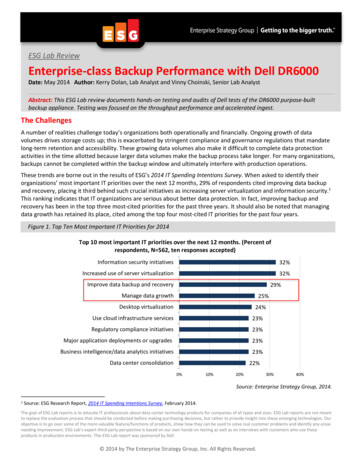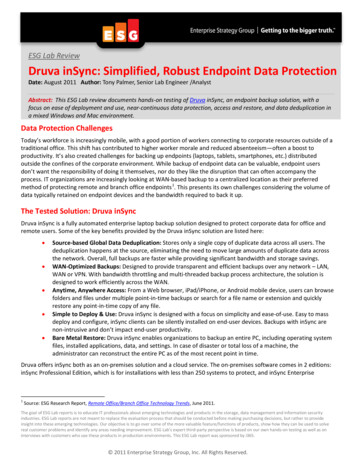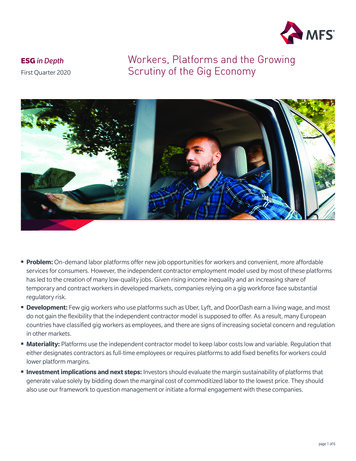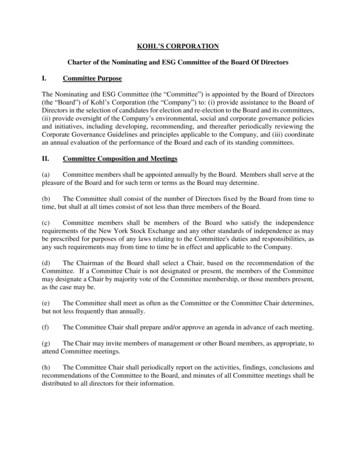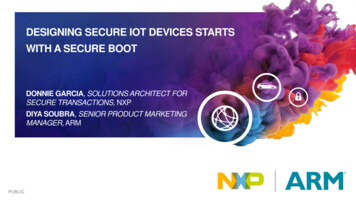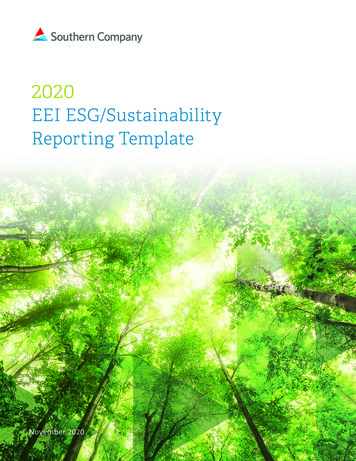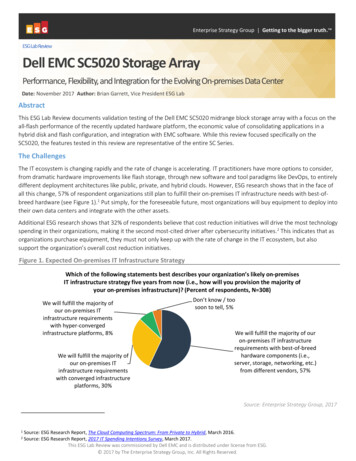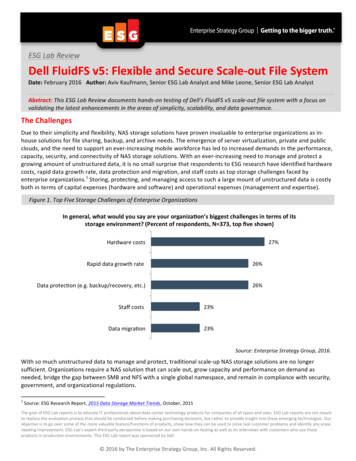
Transcription
ESG Lab ReviewDell FluidFS v5: Flexible and Secure Scale-out File SystemDate: February 2016 Author: Aviv Kaufmann, Senior ESG Lab Analyst and Mike Leone, Senior ESG Lab AnalystAbstract: This ESG Lab Review documents hands-on testing of Dell’s FluidFS v5 scale-out file system with a focus onvalidating the latest enhancements in the areas of simplicity, scalability, and data governance.The ChallengesDue to their simplicity and flexibility, NAS storage solutions have proven invaluable to enterprise organizations as inhouse solutions for file sharing, backup, and archive needs. The emergence of server virtualization, private and publicclouds, and the need to support an ever-increasing mobile workforce has led to increased demands in the performance,capacity, security, and connectivity of NAS storage solutions. With an ever-increasing need to manage and protect agrowing amount of unstructured data, it is no small surprise that respondents to ESG research have identified hardwarecosts, rapid data growth rate, data protection and migration, and staff costs as top storage challenges faced byenterprise organizations.1 Storing, protecting, and managing access to such a large mount of unstructured data is costlyboth in terms of capital expenses (hardware and software) and operational expenses (management and expertise).Figure 1. Top Five Storage Challenges of Enterprise OrganizationsIn general, what would you say are your organiza6on’s biggest challenges in terms of itsstorage environment? (Percent of respondents, N 373, top five shown)Hardware costs27%Rapid data growth rate26%Data protec\on (e.g. backup/recovery, etc.)26%Staff costs23%Data migra\on23%Source: Enterprise Strategy Group, 2016.With so much unstructured data to manage and protect, traditional scale-up NAS storage solutions are no longersufficient. Organizations require a NAS solution that can scale out, grow capacity and performance on demand asneeded, bridge the gap between SMB and NFS with a single global namespace, and remain in compliance with security,government, and organizational regulations.1Source: ESG Research Report, 2015 Data Storage Market Trends, October, 2015The goal of ESG Lab reports is to educate IT professionals about data center technology products for companies of all types and sizes. ESG Lab reports are not meantto replace the evaluation process that should be conducted before making purchasing decisions, but rather to provide insight into these emerging technologies. Ourobjective is to go over some of the more valuable feature/functions of products, show how they can be used to solve real customer problems and identify any areasneeding improvement. ESG Lab’s expert third-party perspective is based on our own hands-on testing as well as on interviews with customers who use theseproducts in production environments. This ESG Lab report was sponsored by Dell. 2016 by The Enterprise Strategy Group, Inc. All Rights Reserved.
ESG Lab Review: Dell FluidFS v5: Flexible and Secure Scale-out File System2The Solution: Dell FluidFS v5 and the FS8600 NAS SolutionDell FluidFS v5 is the fifth generation of Dell’s high performance scale-out file system. FluidFS provides a single, globalnamespace for NFS and SMB clients, greatly simplifying the management of unstructured data, while offering enhanceddata governance and application integration capabilities. FluidFS provides enterprise-class features with simple allinclusive licensing, backed by Dell’s world-class Co-Pilot support.The Dell FS8600 NAS appliance leverages custom Dell hardware that was purpose-built to best support Dell FluidFStechnology. The FS8600 consists of two highly available active-active hot swappable NAS controllers connected througha high performance 40Gbps PCIe midplane. Each controller contains two quad-core Intel Xeon processors, 24-48 GB ofmemory (depending on client network attach option), and an internal HDD for local boot and cache consistency. Theclient network can be connected using 1GbE or 10GbE connections, and the Storage Center SAN can be connected via8Gb Fibre Channel or 10GbE iSCSI.Dell FluidFS v5 running on FS8600 hardware can be deployed as a scale-out clustered file system that leverages DellStorage Center (SC) storage arrays for storage capacity and enterprise storage features. The FS8600 includes all majorfile system features such as snapshots, replication, thin provisioning, and data reduction. Storage capacity andperformance can be scaled non-disruptively and independently of each other by simply adding disks to SC storagesystems, adding additional SC storage systems, or by adding additional FS8600 appliances and/or additional SC storagesystems to the cluster. Host connectivity and data management are greatly simplified since all capacity is provided andmanaged under a single, global namespace (GNS).New features supported in Dell FluidFS v5 Include: Protocol Enhancements: Support for user data via FTP, improved SMB performance (through support ofBranchCache and sparse files), and improved NFS interoperability (support for using the AD Global Catalogas an LDAP repository).VMware Enhancements: Consistent snapshots for VMs running on NFS datastores on FluidFS.Access Control Enhancements: Support for AD Group policy-based file security policies, data governanceaudit support through Dell Change Auditor and other third-party auditing solutions, and the ability to tightensecurity by disabling self-restore by end-users.Architectural Enhancements: Introduction of FluidFS Global Namespace that can provide access to 10s ofPBs of data spread across discrete devices under a single SMB or NFS mount point.Management Enhancements: Support for PowerShell and REST system management APIs for seamlessintegration with existing customer applications.Figure 2. Dell FluidFS v5 Deployed on the FS8600 NAS Appliance 2016 by The Enterprise Strategy Group, Inc. All Rights Reserved.
ESG Lab Review: Dell FluidFS v5: Flexible and Secure Scale-out File System3Simple FlexibilityESG Lab performed remote, hands-on testing of the Dell FluidFS file system running on two separate FS8600 clusterswith block FC storage provided by up to four Dell/Compellent SC4020 storage systems. ESG Lab validated the simplicityand flexibility built into the Dell FluidFS scale-out file system with a goal of seeing how Dell FluidFS can help to simplifythe management of an ever-growing quantity of unstructured data for an organization while keeping that data availableto clients on a global scale under a single namespace. Of particular interest to ESG were some of the new protocol andarchitectural enhancements included in version 5, making cross-protocol client access and file system scalability simpler,with greater flexibility in deployment options. Figure 3 shows the ESG Lab validation test configuration.Figure 3. ESG Lab Test Configuration Used in Hands-on ValidationTo get started, ESG Lab reviewed the steps required to deploy an FS8600 cluster for the first time. One of the key valuepropositions of the FS8600 cluster is that the initial deployment, configuration, installation, and testing are performedby Dell professional services and included in the price of the system. Dell service professionals deploy the FS8600appliances and network connections, and then use Dell Enterprise Manager to connect to the appliance; provide thenecessary IP addresses; set up the network, clustering, and SC storage configuration; and join the Active Directorybefore creating the first NAS storage pool. The entire process is performed in under an hour, removing the burden ofinstallation from the end-user and ensuring that the deployment is protected from any unforeseen issues down theroad.After deploying the initial configuration, consisting of two FS8600 clusters (each connected via FC to a single SC4020storage array), ESG Lab used Dell’s familiar Enterprise Manager software to manage the entire deployment, includingthe FluidFS clusters, FS8600 NAS appliances, and SC4020 storage arrays. Using the simple and intuitive interface, ESG Labcreated a 50TB NAS storage pool that used capacity provided by the SC4020 storage array. The allocation of capacity onthe SC4020 was completely automated and transparent to the administrator, with no additional steps needed to createor map volumes on the SC4020. This, combined with the proven automated tiering capabilities of the SC4020, greatlysimplified the management of storage, saving the administrator valuable time and reducing complexity.ESG Lab then created new thin-provisioned NAS volumes as well as new SMB and NFS shares. It was easy to control theshares access permissions, modify file-based policies, and allow access to clients in a variety of ways (IP address, IP 2016 by The Enterprise Strategy Group, Inc. All Rights Reserved.
ESG Lab Review: Dell FluidFS v5: Flexible and Secure Scale-out File System4address range, subnet, or clients in a Netgroup). Mounting the volumes on clients was just as simple and required noextra steps because the clients were already members of the Active Directory (AD) domain. Even the NFS volumes wereable to leverage the Global AD catalog as an LDAP repository, saving administrators the burden of having to maintainseparate repositories for NAS shares. The mounted volumes simply appeared in the client’s file system automaticallyfollowing creation of the volume. The simple volume creation process and management interface are shown in Figure 4.Figure 4. FluidFS Simplified Management of NAS Volumes and Client ConnectivityNext, ESG Lab validated the ability of Dell FluidFS v5 to non-disruptively scale in a variety of flexible ways. The design ofthe FluidFS architecture allows organizations to scale the capacity and/or performance characteristics of the global filesystem independently of each other. A FluidFS file system can be scaled by adding drives, storage systems or channels,NAS appliances to the cluster, or by adding ports at any level. Not having the capacity tied to the performance meansthat organizations can make better timed choices, enabling them to take advantage of the latest technologies in drives,connectivity options, storage systems, and NAS appliances, if and when they make the most sense to the business.To create a load on the system, ESG Lab used the open source tool, frametest, to simulate a 1.3GB/Sec workload thatconsisted of heavy 12MB video write streams (a workload that might be used by a video surveillance organization, forinstance). It should be noted that this write-intensive workload was used to place a heavy load on the system in order togauge the ability of the solution to provide high levels of performance while scaling capacity and does not represent themaximum performance of the FS8600 NAS scale-out solution. ESG Lab used the performance charting capabilities ofEnterprise Manager to view the performance of the system over time as it was scaled to grow capacity and/orperformance capabilities by adding new components to the configuration.While the workload was running, a second SC4020 was added to the cluster and the NAS pool was extended to a total of100 TB to make use of the new capacity provided by the second array. ESG Lab noted that there was no impact to therunning workload, and that writes (including redirected re-writes) were sent to the newly added SC4020 until systemcapacity was balanced. Up to eight SC arrays could provide storage for a single FluidFS cluster (up to a 4PB single filesystem without the need to use Microsoft DFS), and the SC4020 storage arrays could be used in a unified manner toprovide storage to block-based hosts and the FS8600 cluster simultaneously. ESG Lab was then shown how Dellprofessional services could add a second FS8600 appliance to the cluster with no impact to the running workload,providing greater parallelism and potential performance in both host and storage connectivity.Finally, ESG Lab grew the namespace by giving a mounted host access to a volume located on the second FS8600 clusterthrough redirection. Folder redirection can be used to merge portions of two separate file systems located on differentclusters into a single Global Namespace or mount point for both SMB and NFS clients. This allows organizations to growa namespace without adding any additional hardware to a cluster and may be useful in cases in which organizations ordatasets must be merged while providing a single view to all clients. 2016 by The Enterprise Strategy Group, Inc. All Rights Reserved.
ESG Lab Review: Dell FluidFS v5: Flexible and Secure Scale-out File System5To validate this ability, ESG Lab used two identical FluidFS clusters (each consisting of two FS8600 appliances and twoSC4020 arrays). On the first cluster, we created a file system and a base volume, and added both an NFS export and SMBshare to the root of the volume. On the second cluster, we created a 5TB folder named “/AdditionalData” (with an SMBshare and NFS export that was added to the root of the folder) that would be used to non-disruptively grow the filesystem on the first cluster through redirection of existing NFS and SMB clients to the shares on the second cluster.Under the Global Namespace tab of the “base” NAS volume on the first cluster, we created a redirection folder named“/AddedData” that pointed clients to the virtual IP address of the second cluster and the SMB share and NFS exportassociated with the “/AdditionalData” folder. The folder and additional capacity immediately showed up as a sub-folderunder the base file system on both SMB and NFS clients (as a symbolic link or redirected folder). This redirection abilitygives organizations the ability to provide all clients with a single consistent global namespace for SMB and NFS clientswhile eliminating interoperability issues and complex management procedures. Figure 5 shows the three flexiblemethods validated by ESG Lab to non-disruptively grow the global file system.Figure 5. ESG Lab Validated Flexible Options to Grow Capacity and Performance with Dell FluidFSWhy This MattersNAS storage solutions have been widely adapted in the enterprise, thanks mainly to the ability to effectivelystore and protect large amounts of unstructured data. In fact, 25% of ESG research respondents identified NASas their primary on-premises, disk-based storage technology, making it the most-cited response.2 While scaleout NAS solutions have solved some of the historical problems related to scale, many scale-out NAS storagesolutions remain difficult to deploy and complex to manage. Administrators still struggle with managing accessfor clients across devices and protocols while providing a single unified view of a global namespace.ESG Lab validated that Dell FluidFS was simple to deploy and manage and could be scaled in a variety offlexible ways to match the needs of the business. The file system grew in both capacity and performancecapabilities as we added SC storage systems and FS8600 NAS appliances with no disruption to client activity.FluidFS eliminated most of the complexity of managing unstructured data spread across discrete NAS devicesby providing a global namespace to SMB and NFS clients while eliminating interoperability and managementissues, providing a better end-user experience, and reducing both operational and capital expenses.2Source: ESG Research Report, 2015 Data Storage Market Trends, October 2015. 2016 by The Enterprise Strategy Group, Inc. All Rights Reserved.
ESG Lab Review: Dell FluidFS v5: Flexible and Secure Scale-out File System6Security and Data GovernanceNext, ESG Lab validated some of the ways in which a Dell FluidFS v5 deployment can be used to provide more secureaccess to data for clients and remain in compliance through integration with Dell Change Auditor. With the addedpressure to remain in regulatory compliance and protect against data breaches, it is critical for organizations to knowwho is accessing their data, and how they are doing so. File systems typically rely on system access control lists (ACLs) tocontrol access to data. If an end-user has permissions to modify an ACL, then she can easily get to any file she wants. Tohelp organizations understand and better control data access, Dell FluidFS v5 added support for integration with leadingdata governance tools such as Dell’s own Change Auditor and other third-party auditing solutions. To get a betterunderstanding of this tight integration, ESG Lab performed hands-on validation of some typical data governancescenarios using FluidFS with Dell Change Auditor.Dell Change Auditor can be used to securely audit all activities related to ACLs and file access to the FluidFS file systemas well as to Active Directory, Exchange, Windows file servers, SQL databases, and other applications. Change Auditorcan be installed on a physical or virtual server and uses a SQL database to store events, provide searchable reports, andgenerate alerts on suspicious activity. Agents are deployed as close as possible to monitored devices and a fullycustomizable amount of information is reported back from each monitored device to the Change Auditor database.After installing the SQL database, ESG Lab deployed Change Auditor on a VM by simply defining a name for the instanceand joining it to the Active Directory. The Change Auditor agents were then installed on the Windows servers andautomatically connected to the appropriate Change Auditor coordinator running in the AD. Once installed, we could useEnterprise Manager to see that the FluidFS cluster was actively being audited by Change Auditor. Using the ChangeAuditor interface, we could review any activity on the Dell FluidFS file system. No additional interaction was necessaryon FluidFS or Change Auditor to begin the auditing process. In Change Auditor, it was easy to select which volumes,directories, and file types to monitor and to fully customize the amount of information that was logged to create anoptimal balance between logging overhead and the amount of information gathered. File data on the FluidFS deviceintended for wider consumption could be audited in a quick and simple manner, while access to more sensitiveinformation on the FluidFS system, such as financial data, can be scrutinized much deeper. Figure 6 shows the tightintegration between FluidFS v5 and the Dell Change Auditor interfaces.Figure 6. Integrating Dell Change Auditor with Dell FluidFS v5Next, a set of files was copied to the FluidFS file system and in under ten seconds, the newly written files were visible inthe Change Auditor user interface. Rather than update each file in real time, caches on the FS8600 help to combine andoptimize reported information in consolidated bursts to limit network traffic. ESG Lab then performed some typical fileactivities to the copied files. The Change Auditor interface was then used to easily create filtered searches to query 2016 by The Enterprise Strategy Group, Inc. All Rights Reserved.
ESG Lab Review: Dell FluidFS v5: Flexible and Secure Scale-out File System7events and see when files were opened, modified, deleted, renamed, or copied. File events were categorized and colorcoded by severity for quick visual analysis with simple file operations categorized as medium severity, and modificationsto the Active Directory ACL categorized as high severity.Finally ESG Lab walked through a simulated scenario to see how Change Auditor can be used to better protect anorganization by quickly identifying the possibility of an internal or external data breach. In a directory named “Payroll,”we placed a few simple text files named “CEO Payroll” and “QA Manager” to represent organizationally sensitiveinformation. Using Dell Change Auditor, we then created custom filtered searches and alerts to monitor all actionsrelated to activity on the payroll files and ACLs and then send alerts to both the payroll and security teams shouldanyone access the files. After simply opening the payroll file, ES
audit support through Dell Change Auditor and other third-party auditing solutions, and the ability to tighten security by disabling self-restore by end-users. Architectural Enhancements: Introduction of FluidFS Global Namespace that can provide access to 10s of PBs of data spread acros
